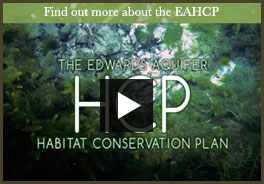Supporting Measures
Net Disturbance & Incidental Take
The Incidental Take Permit (ITP) issued to the Edwards Aquifer Recovery Implementation Program by the U.S. Fish & Wildlife Services authorizes “take” of certain species (“Covered Species”) resulting from aquifer groundwater pumping and recreational and other activities in the Comal and San Marcos springs and river systems.
This “take” is authorized with the provision that a habitat conservation plan to protect the Covered Species is implemented—hence, the Edwards Aquifer Habitat Conservation Plan (EAHCP). The accurate and timely measurement of take—broadly defined as “anything that disrupts the routine activities of the Covered Species”—is fundamental to compliance with the ITP.
For more information concerning take assessment, how the HCP conducts this assessment in the Comal and San Marcos systems, and assessments conducted to date, please read more on the Net Disturbance & Incidental Take page.
Applied Research
The EAHCP Applied Research program is essential in collecting data for the Ecological Model. This effort provides us with a more accurate understanding of the ecological dynamics of the Comal and San Marcos springs, particularly under low-flow conditions.
Click here for all Applied Research final reports.
Ecological Model
The Ecological Model was constructed to simulate population dynamics of the endangered fountain darter in response to changes in habitat conditions that might result directly or indirectly from changes in water flows within the San Marcos and Comal rivers.
Click here for the Ecological Model report documents.
Biological Monitoring
A comprehensive biological monitoring program was established by the EAA in 2000 to gather baseline and critical period data to fill important data gaps in the ecological conditions of the Comal and San Marcos springs ecosystems. This comprehensive monitoring plan will continue to accumulate data for refinement of estimates of “average” conditions. Additional monitoring during low-flow periods will enhance knowledge about the species during various conditions.
Click here for the Biological Monitoring Annual Reports.
Expanded Water Quality Monitoring
The EAA operates water quality monitoring programs in the Comal and San Marcos Rivers as a part of the EAHCP.
Click here to view the Annual Expanded Water Quality Monitoring Reports.
Refugia
EAA will support and coordinate the construction of an off-site refugia facility in order to preserve the covered species population in the event of a catastrophic event such as the unexpected loss of springflow or a chemical spill.
